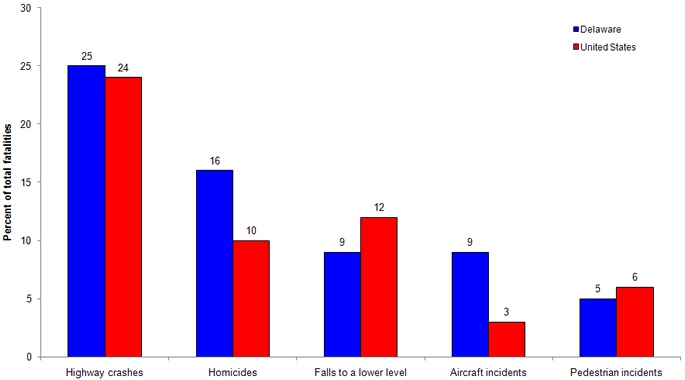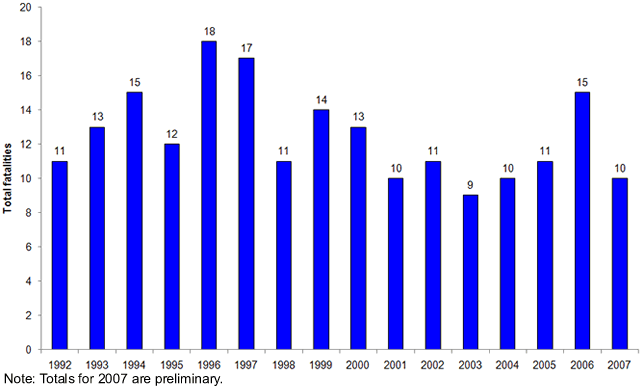Workplace Fatalities in Delaware, 2003-2007 (PDF)
During the years 2003 to 2007, fatal work injuries in Delaware totaled 55, according to the Bureau of Labor Statistics of the U.S. Department of Labor. Sheila Watkins, the Bureau’s regional commissioner, noted that highway crashes were the leading cause of on-the-job fatalities over this time period, accounting for 14 deaths, or 25 percent of the total. (See chart A.) Please note that the 2007 results are preliminary; final results will be released in April 2009. Highway crashes (officially titled highway incidents) accounted for a similar proportion of work-related fatalities in Delaware and in the nation over this five-year span. Fatal work injuries resulting from homicides (9) represented 16 percent of the State’s fatality count; nationwide, homicides made up 10 percent of the total from 2003 to 2007.
Other leading causes of fatal workplace injuries in Delaware for the five-year period from 2003 to 2007 were falls to a lower level (5), aircraft incidents (5), and pedestrian incidents (3). (See table 1.) Fatalities resulting from falls to a lower level and aircraft incidents each accounted for 9 percent of the work-related deaths in the State; these two events made up 12 and 3 percent, respectively, of fatalities nationwide. Pedestrian incidents accounted for 5 percent of all workplace fatalities in Delaware and 6 percent of those throughout the United States.
Chart A. Percent of five-year total of fatal occupational injuries from 2003 to 2007 in Delaware and the United States by selected event groups

The 2007 count of 10 fatal occupational injuries, down from the 15 recorded in 2006, was one of the lowest annual totals recorded in the State since the fatality census began in 1992. Only the 2003 total of nine workplace deaths was lower than that recorded in 2007, while the counts for two other years (2001 and 2004) matched 2007’s level. (See chart B.)Â
Chart B. Â Fatal occupational injuries in Delaware from 1992-2007

Key characteristics of fatal work injuries from 2003 to 2007 in Delaware:
- Men (48) accounted for 87 percent of the work-related fatalities in Delaware. Transportation incidents1, which include highway, nonhighway, pedestrian, air, water, and rail, accounted for 46 percent of deaths among men. Seven women were fatally injured on the job; the fatalities were caused by transportation incidents (4) and assaults and violent acts (3). (See table 2.)
- Eighty percent of those who died from a workplace injury in the State were white, non-Hispanic (44); 7 percent were black, non-Hispanic (4); and 7 percent were Hispanic or Latino (4). Transportation incidents made up the most frequent type of fatality for white, non-Hispanic workers, while assaults and violent acts accounted for the majority of the deaths among black, non-Hispanics. (See table 2.)
- Workers 25-54 years old—the prime working age group—made up 42, or 76 percent, of the work-related fatalities in Delaware from 2003 to 2007. This group represented a higher percentage of the State’s workplace deaths than its 64-percent share nationwide. (See table 2.)
- Ninety-one percent of workers killed on-the-job in the State worked for wages and salaries, the rest were self-employed. The leading cause of death for wage and salary workers was transportation incidents, while falls accounted for the majority of workplace fatalities among the self-employed.  (See table 2.)
- Three industry sectors made up over half of the workplace fatalities in Delaware—construction had 13 fatalities, government had 8, and retail trade had 7. Transportation incidents and contact with objects and equipment accounted for the largest number of fatal occupational injuries in construction, at four each. Work-related deaths in government were mainly the result of transportation incidents, while assaults and violent acts was the most frequent event in retail trade. (See table 3.)
- Workers in the construction and extraction occupations had the highest number of workplace fatalities at 15, followed by those in the transportation and material moving occupations with 9. Combined, these two occupational groups accounted for 44 percent of all fatal work injuries in the State. Transportation incidents, contact with objects and equipment, and exposure to harmful substances or environments accounted for the majority of fatal injuries in the construction and extraction occupations, while in the transportation and material moving occupations, transportation incidents was the most frequent event. (See table 4.)
Additional Census of Fatal Occupational Injuriesdata are available on the BLS Internet site at www.bls.gov/iif/. Data can be accessed in two ways, through Create Customized Tables, which allows quick access to particular items, or via the special request FTP service, which allows access to an extensive collection of flat text files. For personal assistance or further information on the Census of Fatal Occupational Injuries program, as well as other Bureau programs, contact the Mid-Atlantic Information Office at 215-597-3282 from 8:30 a.m. to 12:00 p.m. and 1:00 p.m. to 3:30 p.m. ET. Information on the Census of Fatal Occupational Injuries and other programs and surveys are available on our Web site at www.bls.gov/ro3/.
Technical Note
Background of the program
The Census of Fatal Occupational Injuries, part of the BLS occupational safety and health statistics program, compiles a count of all fatal work injuries occurring in the U.S. in each calendar year. The program uses diverse State, federal, and independent data sources to identify, verify, and describe fatal work injuries. This assures counts are as complete and accurate as possible.
For technical information about the CFOI program, please go to the BLS Handbook of Methods on the BLS Web site. To get to that document, click on Workplace Injuries on the BLS home page, scroll down to IIF Documentation, and then click on “BLS Handbook of Methods.� The technical information and definitions for the CFOI Program are in Chapter 9, Part 2 of the BLS Handbook of Methods.
Federal/State agency coverage
The Census of Fatal Occupational Injuries includes data for all fatal work injuries, whether the decedent was working in a job covered by the Occupational Safety and Health Administration (OSHA) or other federal or State agencies or was outside the scope of regulatory coverage. Thus, any comparison between the BLS fatality census counts and those released by other agencies should take into account the different coverage requirements and definitions being used by each agency.
Several federal and State agencies have jurisdiction over workplace safety and health. OSHA and affiliated agencies in States with approved safety programs cover the largest portion of the nation's workers. However, injuries and illnesses occurring in certain industries or activities, such as coal, metal, and nonmetal mining and highway, water, rail, and air transportation, are excluded from OSHA coverage because they are covered by other federal agencies, such as the Mine Safety and Health Administration and various agencies within the Department of Transportation.
Acknowledgments
BLS thanks the Delaware Department of Labor for their efforts in collecting accurate, comprehensive, and useful data on fatal work injuries. BLS also appreciates the efforts of all federal, State, local, and private sector entities that submitted source documents used to identify fatal work injuries. Among these agencies are the Occupational Safety and Health Administration; the National Transportation Safety Board; the U.S. Coast Guard; the Mine Safety and Health Administration; the Employment Standards Administration (Federal Employees' Compensation and Longshore and Harbor Workers' divisions); the Federal Railroad Administration; the Department of Energy; State vital statistics registrars, coroners, and medical examiners; State departments of health, labor and industries, and workers' compensation agencies; State and local police departments; and State farm bureaus.
1 Fatal events are categorized into several major groupings including transportation incidents, assaults and violent acts, and falls, among others. These major groups are further broken down into more detailed groups. See the Occupational Injury & Illness Classification System (OIICS) Manual on our Web site at www.bls.gov/iif/oshoiics.htm for detailed information on the categories of fatalities used in this census.
|